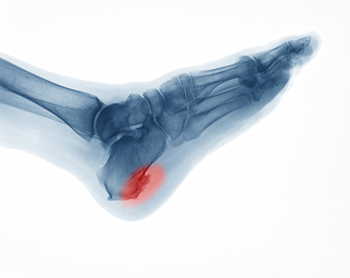Blog
Possible Causes of Blisters
 The most common cause of blisters on the feet is friction. This can happen as a result of wearing shoes and socks that do not fit correctly. Additionally, there may be other circumstances that can cause blisters. These can consist of an allergic reaction to an insect bite, severe sunburn, or medical conditions such as dermatitis. A blister will generally form as the body’s natural reaction to protect skin that has been damaged. It appears as a bubble that is filled with fluid, and will gradually drain when the new skin forms. It may help to wear an elastic bandage over the blister, which can help to protect the area as daily activities are accomplished. If you have a blister on your foot that has become infected, it is advised that you consult with a podiatrist who can offer treatment solutions.
The most common cause of blisters on the feet is friction. This can happen as a result of wearing shoes and socks that do not fit correctly. Additionally, there may be other circumstances that can cause blisters. These can consist of an allergic reaction to an insect bite, severe sunburn, or medical conditions such as dermatitis. A blister will generally form as the body’s natural reaction to protect skin that has been damaged. It appears as a bubble that is filled with fluid, and will gradually drain when the new skin forms. It may help to wear an elastic bandage over the blister, which can help to protect the area as daily activities are accomplished. If you have a blister on your foot that has become infected, it is advised that you consult with a podiatrist who can offer treatment solutions.
Blisters may appear as a single bubble or in a cluster. They can cause a lot of pain and may be filled with pus, blood, or watery serum. If your feet are hurting, contact Elliot T. Udell, DPM of New York. Our doctor can provide the care you need to keep you pain-free and on your feet.
Foot Blisters
Foot blisters are often the result of friction. This happens due to the constant rubbing from shoes, which can lead to pain.
What Are Foot Blisters?
A foot blister is a small fluid-filled pocket that forms on the upper-most layer of the skin. Blisters are filled with clear fluid and can lead to blood drainage or pus if the area becomes infected.
Symptoms
(Blister symptoms may vary depending on what is causing them)
- Bubble of skin filled with fluid
- Redness
- Moderate to severe pain
- Itching
Prevention & Treatment
In order to prevent blisters, you should be sure to wear comfortable shoes with socks that cushion your feet and absorb sweat. Breaking a blister open may increase your chances of developing an infection. However, if your blister breaks, you should wash the area with soap and water immediately and then apply a bandage to the affected area. If your blisters cause severe pain it is important that you call your podiatrist right away.
If you have any questions, please feel free to contact our office located in Hicksville, NY . We offer the newest diagnostic and treatment technologies for all your foot care needs.
Frequent Eye Exams May Help To Prevent Falling
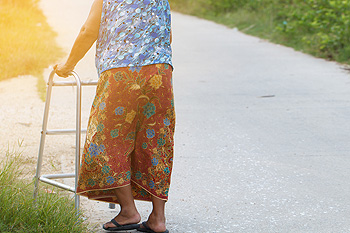 Many people who are over the age of sixty-five are aware of the injuries that may occur from falling. A broken foot may be a common ailment that can happen as a result of falling. Research has indicated that falls are the leading cause of injuries that elderly people endure. There are measures that can be implemented which may help to reduce the risk of falling. These can include removing worn carpets from the living environment, improving the lighting in the house, and installing grab bars in the toilets and shower area. Additionally, seniors may experience dehydration and poor eating habits, which may lead to reduced strength. These factors can help to increase the risk of falling. It may be beneficial to have frequent eye exams performed. This may help to prevent tripping over objects which may not have been seen. If you would like more information about how falling can affect the feet, please consult with a podiatrist.
Many people who are over the age of sixty-five are aware of the injuries that may occur from falling. A broken foot may be a common ailment that can happen as a result of falling. Research has indicated that falls are the leading cause of injuries that elderly people endure. There are measures that can be implemented which may help to reduce the risk of falling. These can include removing worn carpets from the living environment, improving the lighting in the house, and installing grab bars in the toilets and shower area. Additionally, seniors may experience dehydration and poor eating habits, which may lead to reduced strength. These factors can help to increase the risk of falling. It may be beneficial to have frequent eye exams performed. This may help to prevent tripping over objects which may not have been seen. If you would like more information about how falling can affect the feet, please consult with a podiatrist.
Preventing falls among the elderly is very important. If you are older and have fallen or fear that you are prone to falling, consult with Elliot T. Udell, DPM from New York. Our doctor will assess your condition and provide you with quality advice and care.
Every 11 seconds, an elderly American is being treated in an emergency room for a fall related injury. Falls are the leading cause of head and hip injuries for those 65 and older. Due to decreases in strength, balance, senses, and lack of awareness, elderly persons are very susceptible to falling. Thankfully, there are a number of things older persons can do to prevent falls.
How to Prevent Falls
Some effective methods that older persons can do to prevent falls include:
- Enrolling in strength and balance exercise program to increase balance and strength
- Periodically having your sight and hearing checked
- Discuss any medications you have with a doctor to see if it increases the risk of falling
- Clearing the house of falling hazards and installing devices like grab bars and railings
- Utilizing a walker or cane
- Wearing shoes that provide good support and cushioning
- Talking to family members about falling and increasing awareness
Falling can be a traumatic and embarrassing experience for elderly persons; this can make them less willing to leave the house, and less willing to talk to someone about their fears of falling. Doing such things, however, will increase the likelihood of tripping or losing one’s balance. Knowing the causes of falling and how to prevent them is the best way to mitigate the risk of serious injury.
If you have any questions, please feel free to contact our office located in Hicksville, NY . We offer the newest diagnostic and treatment technologies for all your foot care needs.
Examples of Foot Exercises and Why They Matter
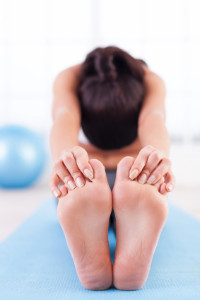 To avoid dealing with issues such as foot and ankle pain, muscle soreness, and to improve the overall health of your feet, it is recommended that you perform foot exercises. When you perform exercises designed for the feet, you help to strengthen the foot muscles, which may provide better support, stability, and protection. One simple exercise you can do is called the three-step “toe raise, point, and curl.” Imagine you’re making little waves with your toes when trying out this exercise. Another exercise is called the “toe splay,” where you practice by spreading all of your toes. Lastly, you can try “toe extensions” which is done by grabbing your toes with your fingers and gently pulling them backwards. If you are concerned with the health of your feet, or would like information about additional stretches, we recommend that you consult with a podiatrist.
To avoid dealing with issues such as foot and ankle pain, muscle soreness, and to improve the overall health of your feet, it is recommended that you perform foot exercises. When you perform exercises designed for the feet, you help to strengthen the foot muscles, which may provide better support, stability, and protection. One simple exercise you can do is called the three-step “toe raise, point, and curl.” Imagine you’re making little waves with your toes when trying out this exercise. Another exercise is called the “toe splay,” where you practice by spreading all of your toes. Lastly, you can try “toe extensions” which is done by grabbing your toes with your fingers and gently pulling them backwards. If you are concerned with the health of your feet, or would like information about additional stretches, we recommend that you consult with a podiatrist.
Exercising your feet regularly with the proper foot wear is a great way to prevent injuries and build strength. If you have any concerns about your feet, contact Elliot T. Udell, DPM from New York. Our doctor can provide the care you need to keep you pain-free and on your feet.
Exercise for Your Feet
Exercise for your feet can help you gain strength, mobility and flexibility in your feet. They say that strengthening your feet can be just as rewarding as strengthening another part of the body. Your feet are very important, and we often forget about them in our daily tasks. But it is because of our feet that are we able to get going and do what we need to. For those of us fortunate enough to not have any foot problems, it is an important gesture to take care of them to ensure good health in the long run.
Some foot health exercises can include ankle pumps, tip-toeing, toe rises, lifting off the floor doing reps and sets, and flexing the toes. It is best to speak with Our doctor to determine an appropriate regimen for your needs. Everyone’s needs and bodies are different, and the activities required to maintain strength in the feet vary from individual to individual.
Once you get into a routine of doing regular exercise, you may notice a difference in your feet and how strong they may become.
If you have any questions please feel free to contact our office located in Hicksville, NY . We offer the newest diagnostic and treatment technologies for all your foot and ankle needs.
Before you start dancing...
What is a Heel Spur and How Can it be Treated?
A heel spur may occur when a calcium deposit develops between the arch of the foot and the heel. A common symptom of a heel spur often includes a sharp, intense pain when standing up in the morning. Additional signs you may have a heel spur may consist of an ache, inflammation or swelling in the heel, heat radiating from the affected area, and a noticeable protrusion under the heel. Factors that increase the risk of obtaining a heel spur can include being involved in athletic activities, experiencing trauma to the heel, general aging, and wearing improper footwear. Getting proper rest, and using custom made orthotics may help to alleviate any pain or pressure that exists as a result of a heel spur. If you would like additional information and advice for an effective treatment regime, we recommend that you consult with a podiatrist.
Heel spurs can be incredibly painful and sometimes may make you unable to participate in physical activities. To get medical care for your heel spurs, contact Elliot T. Udell, DPM from New York. Our doctor will do everything possible to treat your condition.
Heels Spurs
Heel spurs are formed by calcium deposits on the back of the foot where the heel is. This can also be caused by small fragments of bone breaking off one section of the foot, attaching onto the back of the foot. Heel spurs can also be bone growth on the back of the foot and may grow in the direction of the arch of the foot.
Older individuals usually suffer from heel spurs and pain sometimes intensifies with age. One of the main condition's spurs are related to is plantar fasciitis.
Pain
The pain associated with spurs is often because of weight placed on the feet. When someone is walking, their entire weight is concentrated on the feet. Bone spurs then have the tendency to affect other bones and tissues around the foot. As the pain continues, the feet will become tender and sensitive over time.
Treatments
There are many ways to treat heel spurs. If one is suffering from heel spurs in conjunction with pain, there are several methods for healing. Medication, surgery, and herbal care are some options.
If you have any questions feel free to contact our office located in Hicksville, NY . We offer the latest in diagnostic and treatment technology to meet your needs.
What Can Cause An Ingrown Toenail?
Many patients experience the pain and discomfort an ingrown toenail can cause. Ingrown toenails happen as a result of the outer edges of the nail growing into the skin. The symptoms that are often associated with this ailment can include swelling, redness, and in severe cases, there may be a discharge that oozes from the edge of the nail. This condition can be caused by wearing shoes that do not have have enough room for the toes to move freely in, in addition to trimming toenails too short or incorrectly. Patients may find relief when the affected toe is soaked in warm water, followed by inserting a small piece of cotton under the edge. This may help to gradually lift the nail away from the nail bed. If you have an ingrown toenail, it is suggested that you consult with a podiatrist who can offer you correct treatment options, which may include surgically removing a portion of the nail.
Ingrown toenails may initially present themselves as a minor discomfort, but they may progress into an infection in the skin without proper treatment. For more information about ingrown toenails, contact Elliot T. Udell, DPM of New York. Our doctor can provide the care you need to keep you pain-free and on your feet.
Ingrown Toenails
Ingrown toenails are caused when the corner or side of a toenail grows into the soft flesh surrounding it. They often result in redness, swelling, pain, and in some cases, infection. This condition typically affects the big toe and may recur if it is not treated properly.
Causes
- Improper toenail trimming
- Genetics
- Improper shoe fitting
- Injury from pedicures or nail picking
- Abnormal gait
- Poor hygiene
You are more likely to develop an ingrown toenail if you are obese, have diabetes, arthritis, or have any fungal infection in your nails. Additionally, people who have foot or toe deformities are at a higher risk of developing an ingrown toenail.
Symptoms
Some symptoms of ingrown toenails are redness, swelling, and pain. In rare cases, there may be a yellowish drainage coming from the nail.
Treatment
Ignoring an ingrown toenail can have serious complications. Infections of the nail border can progress to a deeper soft-tissue infection, which can then turn into a bone infection. You should always speak with your podiatrist if you suspect you have an ingrown toenail, especially if you have diabetes or poor circulation.
If you have any questions, please feel free to contact our office located in Hicksville, NY . We offer the newest diagnostic and treatment technologies for all your foot care needs.
Why Choose Foot Surgery?
 Many patients choose to have foot surgery performed as an option to relieve severe pain and discomfort. Relief may be found when toenail removal is chosen to correct chronically infected ingrown toenails. Bunion surgery may be a choice to consider if the bunion is painful and unsightly. Research has indicated it is helpful to wear orthotics following a bunionectomy, as this may help to achieve long lasting relief. If pain is felt from a deformed ankle, the surgery that may help diminish the discomfort is referred to as an ankle fusion. Additionally, this type of surgery may help patients who have ankle arthritis, and neuromuscular disorders. If you have foot pain, and are considering surgery, it is strongly advised that you schedule a consultation with a podiatrist who can properly guide you toward making the choice that is correct for you.
Many patients choose to have foot surgery performed as an option to relieve severe pain and discomfort. Relief may be found when toenail removal is chosen to correct chronically infected ingrown toenails. Bunion surgery may be a choice to consider if the bunion is painful and unsightly. Research has indicated it is helpful to wear orthotics following a bunionectomy, as this may help to achieve long lasting relief. If pain is felt from a deformed ankle, the surgery that may help diminish the discomfort is referred to as an ankle fusion. Additionally, this type of surgery may help patients who have ankle arthritis, and neuromuscular disorders. If you have foot pain, and are considering surgery, it is strongly advised that you schedule a consultation with a podiatrist who can properly guide you toward making the choice that is correct for you.
Foot surgery is sometimes necessary to treat a foot ailment. To learn more, contact Elliot T. Udell, DPM of New York. Our doctor will assist you with all of your foot and ankle needs.
When Is Surgery Necessary?
Foot and ankle surgery is generally reserved for cases in which less invasive, conservative procedures have failed to alleviate the problem. Some of the cases in which surgery may be necessary include:
- Removing foot deformities like bunions and bone spurs
- Severe arthritis that has caused bone issues
- Cosmetic reconstruction
What Types of Surgery Are There?
The type of surgery you receive will depend on the nature of the problem you have. Some of the possible surgeries include:
- Bunionectomy for painful bunions
- Surgical fusion for realignment of bones
- Neuropathy decompression surgery to treat nerve damage
Benefits of Surgery
Although surgery is usually a last resort, it can provide more complete pain relief compared to non-surgical methods and may allow you to finally resume full activity.
Surgical techniques have also become increasingly sophisticated. Techniques like endoscopic surgery allow for smaller incisions and faster recovery times.
If you have any questions please feel free to contact our office located in Hicksville, NY . We offer the newest diagnostic and treatment technologies for all your foot and ankle needs.
Achilles Tendon Injuries Can Cause Severe Pain
The Achilles tendon is found in the back of the calf, and it connects the calf muscles to the heel. This portion of tissue is instrumental in allowing the foot to point and flex, in addition to performing activities that include running, jumping, and walking. If the Achilles tendon becomes damaged as a result of a fall or injury, immediate and severe pain is often felt. There are common reasons why this type of injury may occur. These can consist of calf muscles that have not been stretched properly before beginning a new sport, wearing shoes that do not fit correctly, or increasing the intensity of a sporting activity. Many patients find the affected leg is painful in the morning upon arising, and it may become swollen as daily activities are pursued. There are specific stretches that can be performed which may bring moderate relief. If you are afflicted with an Achilles tendon injury, it is advised that you consult with a podiatrist who guide you toward proper treatment options.
Achilles tendon injuries need immediate attention to avoid future complications. If you have any concerns, contact Elliot T. Udell, DPM of New York. Our doctor can provide the care you need to keep you pain-free and on your feet.
What Is the Achilles Tendon?
The Achilles tendon is a tendon that connects the lower leg muscles and calf to the heel of the foot. It is the strongest tendon in the human body and is essential for making movement possible. Because this tendon is such an integral part of the body, any injuries to it can create immense difficulties and should immediately be presented to a doctor.
What Are the Symptoms of an Achilles Tendon Injury?
There are various types of injuries that can affect the Achilles tendon. The two most common injuries are Achilles tendinitis and ruptures of the tendon.
Achilles Tendinitis Symptoms
- Inflammation
- Dull to severe pain
- Increased blood flow to the tendon
- Thickening of the tendon
Rupture Symptoms
- Extreme pain and swelling in the foot
- Total immobility
Treatment and Prevention
Achilles tendon injuries are diagnosed by a thorough physical evaluation, which can include an MRI. Treatment involves rest, physical therapy, and in some cases, surgery. However, various preventative measures can be taken to avoid these injuries, such as:
- Thorough stretching of the tendon before and after exercise
- Strengthening exercises like calf raises, squats, leg curls, leg extensions, leg raises, lunges, and leg presses
If you have any questions please feel free to contact our office located in Hicksville, NY . We offer the newest diagnostic tools and technology to treat your foot and ankle needs.
Does Weight Gain Impact the Feet?
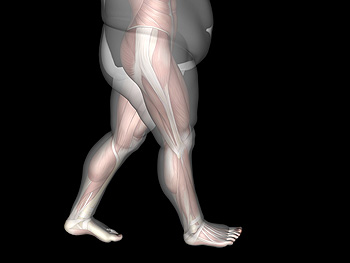 Research has found that having excess body weight may cause a variety of painful foot conditions. Carrying this additional weight may change your posture and this may cause the knees to move closer together while walking. As a result of this, the weight of the body may shift to the inside of the feet. This may negatively affect the arches and tendons in the ankles and feet. Diabetes is one of the greatest risk factors associated with being overweight. This condition can cause numbness in the feet by reducing blood flow. Injuries may develop without being noticed, and cuts or wounds may heal very slowly. If left untreated, infections may occur, which can possibly lead to amputation. It is important to speak to your podiatrist about any foot or ankle pain you experience from weight gain. Your podiatrist will help you determine, along with diet and a gentle exercise routine, your best treatment options.
Research has found that having excess body weight may cause a variety of painful foot conditions. Carrying this additional weight may change your posture and this may cause the knees to move closer together while walking. As a result of this, the weight of the body may shift to the inside of the feet. This may negatively affect the arches and tendons in the ankles and feet. Diabetes is one of the greatest risk factors associated with being overweight. This condition can cause numbness in the feet by reducing blood flow. Injuries may develop without being noticed, and cuts or wounds may heal very slowly. If left untreated, infections may occur, which can possibly lead to amputation. It is important to speak to your podiatrist about any foot or ankle pain you experience from weight gain. Your podiatrist will help you determine, along with diet and a gentle exercise routine, your best treatment options.
Obesity has become very problematic at this point in time and can have extremely negative effects on the feet. If you’re an obese individual and are concerned about your feet, contact Elliot T. Udell, DPM from New York. Our doctor can provide the care you need to keep you pain-free and on your feet.
Obesity and Your Feet
Since your feet are what support your entire weight when standing, any additional weight can result in pain and swelling. Being overweight is one of the main contributors to foot complications.
Problems & Complications
Extra Weight – Even putting on just a few extra pounds could create serious complications for your feet. As your weight increases, your balance and body will shift, creating new stresses on your feet. This uneven weight distribution can cause pain, even while doing the simplest tasks, such as walking.
Diabetes – People who are overweight are at serious risk of developing type-2 diabetes, which has a drastic impact on the health of your feet. As you get older, your diabetes might worsen, which could lead to loss of feeling in your feet, sores, and bruises. You could also become more prone to various infections.
Plantar fasciitis – Pressure and stress that is placed on muscles, joints, and tendons can trigger plantar fasciitis, which is an inflammation of tissue that forms along the bottom of the foot.
If you have any questions please feel free to contact our office located in Hicksville, NY . We offer the newest diagnostic and treatment technologies for all your foot and ankle needs.
Wounds That Don't Heal Need to Be Checked
More...
Repetitive Motions and Stress Fractures
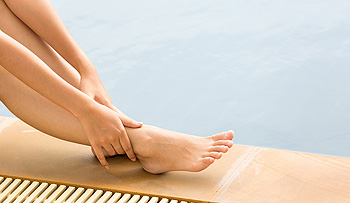 The causes of stress fractures often include an injury to the bone that has occurred from overuse. Research has indicated the feet may endure approximately twelve times the weight of the body as each step is taken. The symptoms that are most often noticed are pain while walking or running, in addition to swelling and tenderness. Stress fractures are commonly caused by repetitive motion that may come from participating in running and jumping activities. If the injury is treated when the symptoms are first noticed, mild relief may be found when the affected foot is elevated, and the activity that caused the injury is ceased. For more severe stress fractures, it is advised that you seek the counsel of a podiatrist who can properly diagnosis and treat stress fractures.
The causes of stress fractures often include an injury to the bone that has occurred from overuse. Research has indicated the feet may endure approximately twelve times the weight of the body as each step is taken. The symptoms that are most often noticed are pain while walking or running, in addition to swelling and tenderness. Stress fractures are commonly caused by repetitive motion that may come from participating in running and jumping activities. If the injury is treated when the symptoms are first noticed, mild relief may be found when the affected foot is elevated, and the activity that caused the injury is ceased. For more severe stress fractures, it is advised that you seek the counsel of a podiatrist who can properly diagnosis and treat stress fractures.
Stress fractures occur when there is a tiny crack within a bone. To learn more, contact Elliot T. Udell, DPM from New York. Our doctor can provide the care you need to keep you pain free and on your feet.
How Are They Caused?
Stress fractures are the result of repetitive force being placed on the bone. Since the lower leg and feet often carry most of the body’s weight, stress fractures are likely to occur in these areas. If you rush into a new exercise, you are more likely to develop a stress fracture since you are starting too much, too soon. Pain resulting from stress fractures may go unnoticed at first, however it may start to worsen over time.
Risk Factors
- Gender – They are more commonly found in women compared to men.
- Foot Problems – People with unusual arches in their feet are more likely to develop stress fractures.
- Certain Sports – Dancers, gymnasts, tennis players, runners, and basketball players are more likely to develop stress fractures.
- Lack of Nutrients – A lack of vitamin D and calcium may weaken the bones and make you more prone to stress fractures
- Weak Bones – Osteoporosis can weaken the bones therefore resulting in stress fractures
Stress fractures do not always heal properly, so it is important that you seek help from a podiatrist if you suspect you may have one. Ignoring your stress fracture may cause it to worsen, and you may develop chronic pain as well as additional fractures.
If you have any questions, please feel free to contact our office located in Hicksville, NY . We offer the newest diagnostic and treatment technologies for all your foot care needs.
What Causes Swollen Feet During Pregnancy?
 Many pregnant women often notice that their feet are swollen. Hormone changes can play a significant role in developing swollen feet, in addition to the weight that is gained. Swelling may increase as the due date approaches and may be especially uncomfortable in warmer weather. If the swelling is mild, there’s typically no reason to be concerned. Some pregnant women have found methods that can reduce swelling, such as lying on the left side while sleeping, and drinking plenty of fresh water. It may also help to elevate the feet frequently during the day. Stretching regularly may also be beneficial in reducing swollen ankles and feet. If you would like more information about how to manage swollen feet during pregnancy, speak to your local podiatrist.
Many pregnant women often notice that their feet are swollen. Hormone changes can play a significant role in developing swollen feet, in addition to the weight that is gained. Swelling may increase as the due date approaches and may be especially uncomfortable in warmer weather. If the swelling is mild, there’s typically no reason to be concerned. Some pregnant women have found methods that can reduce swelling, such as lying on the left side while sleeping, and drinking plenty of fresh water. It may also help to elevate the feet frequently during the day. Stretching regularly may also be beneficial in reducing swollen ankles and feet. If you would like more information about how to manage swollen feet during pregnancy, speak to your local podiatrist.
Pregnant women with swollen feet can be treated with a variety of different methods that are readily available. For more information about other cures for swollen feet during pregnancy, consult with Elliot T. Udell, DPM from New York. Our doctor will attend to all of your foot and ankle needs.
What Foot Problems Can Arise During Pregnancy?
One problem that can occur is overpronation, which occurs when the arch of the foot flattens and tends to roll inward. This can cause pain and discomfort in your heels while you’re walking or even just standing up, trying to support your baby.
Another problem is edema, or swelling in the extremities. This often affects the feet during pregnancy but tends to occur in the later stages.
How Can I Keep My Feet Healthy During Pregnancy?
- Wearing orthotics can provide extra support for the feet and help distribute weight evenly
- Minimize the amount of time spent walking barefoot
- Wear shoes with good arch support
- Wear shoes that allow for good circulation to the feet
- Elevate feet if you experience swelling
- Massage your feet
- Get regular, light exercise, such as walking, to promote blood circulation to the feet
If you have any questions please feel free to contact our office located in Hicksville, NY . We offer the newest diagnostic and treatment technologies for all your foot and ankle needs.
Can Running Injuries Be Prevented?
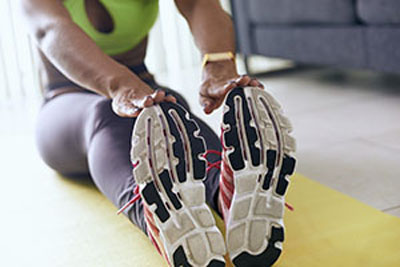 The sport of running is known to be therapeutic and enjoyable. Research has indicated there are methods which can be implemented which may prevent painful running injuries. When the legs and feet are warmed up, the muscles become flexible, and can be less prone to having an injury occur. This can be accomplished by performing leg swings. It is beneficial to perform this type of stretch by standing on one leg, and swinging the other leg forward and backward. This can be instrumental in developing strength. It is helpful to run with a specific reason in mind, which can vary from running up and down hills to running on smooth pavement. This awareness may prevent running injuries by focusing on what type of steps are being taken. Additionally, it helps the body to run in small increments on a daily basis, and this may help to keep the body limber. If you would like additional information about how to prevent running injuries, please schedule a consultation with a podiatrist.
The sport of running is known to be therapeutic and enjoyable. Research has indicated there are methods which can be implemented which may prevent painful running injuries. When the legs and feet are warmed up, the muscles become flexible, and can be less prone to having an injury occur. This can be accomplished by performing leg swings. It is beneficial to perform this type of stretch by standing on one leg, and swinging the other leg forward and backward. This can be instrumental in developing strength. It is helpful to run with a specific reason in mind, which can vary from running up and down hills to running on smooth pavement. This awareness may prevent running injuries by focusing on what type of steps are being taken. Additionally, it helps the body to run in small increments on a daily basis, and this may help to keep the body limber. If you would like additional information about how to prevent running injuries, please schedule a consultation with a podiatrist.
Exercising your feet regularly with the proper foot wear is a great way to prevent injuries. If you have any concerns about your feet, contact Elliot T. Udell, DPM of New York. Our doctor will treat your foot and ankle needs.
How to Prevent Running Injuries
Many common running injuries are caused by overuse and overtraining. When the back of the kneecap starts wearing out and starts causing pain in your knee, this is commonly referred to as runner’s knee. Runner’s knee is a decrease in strength in your quadriceps and can occur if you’re not wearing properly fitted or supporting shoes. To prevent runner’s knee, focusing on hip strengthening is a good idea, as well as strengthening your quads to keep the kneecaps aligned.
What Are Some Causes of Running Injuries?
- One cause of a common running injury is called iliotibial band syndrome.
- Plantar fasciitis is also another common injury.
- Stress fractures can occur from overtraining, lack of calcium, or even your running style.
Best Ways to Prevent Running Injuries
- Wear footwear that fits properly and suits your running needs.
- Running shoes are the only protective gear that runners have to safeguard them from injury.
- Make a training schedule. Adding strengthening exercises as well as regular stretching can help keep you strong and limber and can lessen the possibility of injuries.
- Stretching keeps muscles limber; this will help you gain better flexibility.
If you have any questions please feel free to contact our office located in Hicksville, NY . We offer the newest diagnostic and treatment technologies for all your foot and ankle needs.
U.S. Forward Suffers Ankle Sprain
 Jayson Tatum, forward for the Boston Celtics and currently playing for the U.S. men's national basketball team at the World Cup, suffered a sprained ankle during the American win over Turkey on Tuesday, September 3rd. The game went into overtime and ended with the U.S. prevailing 93-92. The sprain occurred in the course of the game’s final possession and was confirmed the following day after tests. “I think I just slipped and fell the wrong way,” said Tatum of the injury. The consequential sprain kept Tatum out of the Americans’ games against Japan and Greece. Fortunately, Brad Stevens, coach of the Boston Celtics, expressed that the ankle sprain wasn’t serious. If you’re suffering from a sprained ankle, consult with your podiatrist for a proper evaluation.
Jayson Tatum, forward for the Boston Celtics and currently playing for the U.S. men's national basketball team at the World Cup, suffered a sprained ankle during the American win over Turkey on Tuesday, September 3rd. The game went into overtime and ended with the U.S. prevailing 93-92. The sprain occurred in the course of the game’s final possession and was confirmed the following day after tests. “I think I just slipped and fell the wrong way,” said Tatum of the injury. The consequential sprain kept Tatum out of the Americans’ games against Japan and Greece. Fortunately, Brad Stevens, coach of the Boston Celtics, expressed that the ankle sprain wasn’t serious. If you’re suffering from a sprained ankle, consult with your podiatrist for a proper evaluation.
Ankle sprains are common but need immediate attention. If you need your feet checked, contact Elliot T. Udell, DPM from New York. Our doctor can provide the care you need to keep you pain-free and on your feet.
How Does an Ankle Sprain Occur?
Ankle sprains take place when the ligaments in your ankle are torn or stretched beyond their limits. There are multiple ways that the ankle can become injured, including twisting or rolling over onto your ankle, putting undue stress on it, or causing trauma to the ankle itself.
What Are the Symptoms?
- Mild to moderate bruising
- Limited mobility
- Swelling
- Discoloration of the skin (depending on severity)
Preventing a Sprain
- Wearing appropriate shoes for the occasion
- Stretching before exercises and sports
- Knowing your limits
Treatment of a Sprain
Treatment of a sprain depends on the severity. Many times, people are told to rest and remain off their feet completely, while others are given an air cast. If the sprain is very severe, surgery may be required.
If you have suffered an ankle sprain previously, you may want to consider additional support such as a brace and regular exercises to strengthen the ankle.
If you have any questions please feel free to contact our office located in Hicksville, NY . We offer the newest diagnostic and treatment technologies for all your foot and ankle needs.

